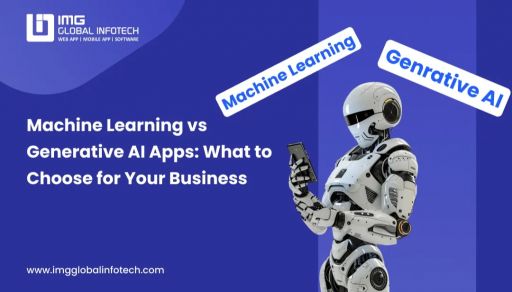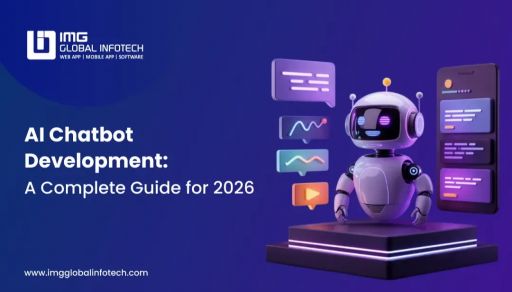Conversational AI Vs Generative AI: Understanding The Key Differences
Neeraj Rajput
Jul 05, 2025

Artificial Intelligence (AI) has become a fundamental of digital innovation, shaping the way businesses interact with customers, automate workflows, and deliver personalized experiences. Among the most talked-about categories within AI are Conversational AI and Generative AI. Although both fall under the broader AI industry, they serve fundamentally different purposes and use distinct technologies.
In today’s competitive landscape, companies are increasingly adopting AI to enhance productivity, automate tasks, and drive customer engagement. But before integrating AI into your product or service, it’s essential to understand which type of AI aligns best with your business goals. Should you implement a smart chatbot to handle customer queries, or would an AI model that writes blog posts, generates artwork, or codes be more impactful?
This guide breaks down the key differences between Conversational AI vs Generative AI, highlights their individual strengths, and helps you make an informed decision based on real-world applications.
What is Conversational AI?

Conversational AI refers to a set of technologies that allow machines to engage in human-like dialogue. Its main goal is to simulate natural, meaningful conversations between users and computer systems. You’ve likely interacted with Conversational AI through free AI chatbots on websites, voice assistants like Siri or Alexa, or automated customer support systems.
At its core, Conversational AI integrates multiple technologies to understand and respond appropriately to human input. These include:
-
Natural Language Processing (NLP): Helps the system understand and interpret user language.
-
Automatic Speech Recognition (ASR): Converts spoken words into text for processing.
-
Dialog Management: Manages the flow and context of conversations.
-
Machine Learning (ML): Enables the system to learn from past interactions and improve over time.
Key Applications of Conversational AI:
-
Customer Support Chatbots: Answer frequently asked questions and resolve issues instantly.
-
Virtual Personal Assistants: Schedule meetings, set reminders, or play music via voice commands.
-
E-commerce Assistants: Help users find products, track orders, or get recommendations.
-
Healthcare Assistants: Offer appointment scheduling, symptom checking, or wellness tracking.
What is Generative AI?

Generative AI refers to a class of artificial intelligence models designed to create new and original content, whether it's text, images, music, video, code, or even speech. Rather than simply responding to predefined commands or scripts, generative AI tools use vast amounts of data to learn patterns and generate outputs that mimic human creativity.
At the heart of generative AI are deep learning techniques such as:
-
Transformers (like GPT, BERT): Powerful language models trained on massive datasets to understand context, tone, and structure.
-
GANs (Generative Adversarial Networks): Often used in image and video generation by pitting two neural networks against each other to refine the output
-
Diffusion Models: Used in tools like DALL·E and Midjourney to create high-quality images from textual input.
Key Applications of Generative AI:
-
Content Creation: Writing articles, product descriptions, emails, or marketing copy.
-
Code Generation: Assisting developers by generating or debugging code snippets.
-
Image and Video Generation: Creating artwork, avatars, marketing visuals, or realistic simulations.
-
Audio & Music Production: Generating soundtracks, voiceovers, or custom audio effects.
Conversational AI vs Generative AI: Key Differences

Although Conversational AI and Generative AI are both powered by artificial intelligence, they serve different functions and operate using distinct technologies. Understanding these differences is essential for selecting the right AI app development solution for your business or project. Let’s explore the key aspects one by one:
1. Primary Purpose
The main goal of Conversational AI is to enable two-way communication between humans and machines. It’s designed to simulate natural dialogue, helping users get information, complete tasks, or receive support. Whether it’s answering customer queries or booking an appointment, conversational AI excels at facilitating structured, interactive exchanges.
In contrast, Generative AI is focused on creating new content. Its primary role is to produce original data such as text, images, code, or audio, based on patterns it has learned from massive training datasets. Rather than responding to inquiries, it delivers entirely new outputs, making it a creative force across industries.
2. Output Type
Conversational AI typically generates short, contextual responses meant to mimic natural human conversation. These outputs are guided by the user’s queries and usually stay within a specific domain or topic. Its strength lies in producing coherent and accurate replies in real time.
Generative AI, on the other hand, delivers long-form or high-volume content that may include paragraphs of text, original designs, lines of code, or synthesized audio. It doesn’t just respond, it creates something new, often with minimal user input.
3. Technology Used
Conversational AI relies heavily on technologies like Natural Language Processing (NLP), Automatic Speech Recognition (ASR), and dialogue management systems. These tools help it understand user intent, maintain context, and respond appropriately. It often uses supervised learning and reinforcement learning to improve over time.
Generative AI uses more advanced models like transformers (e.g., GPT-4, BERT), Generative Adversarial Networks (GANs), and diffusion models. These deep learning systems are trained on vast datasets, enabling the AI apps to learn intricate patterns and generate creative, contextually relevant output.
4. User Interaction
With Conversational AI, the user experience is typically reactive and goal-oriented. Users input questions or commands, and the AI responds within a set framework. It excels at handling FAQs, processing service requests, or navigating menu-based interactions.
Generative AI is more proactive. Once given a prompt, it can independently produce creative or complex results. The interaction is often less structured and allows for more flexibility, especially in applications like storytelling, coding, or visual content generation.
5. Use Case Examples
Conversational AI is widely used in customer support chatbots, virtual voice assistants, IVR systems, and automated helpdesks. It’s ideal for businesses looking to automate human interaction and improve customer service efficiency.
Meanwhile, Generative AI powers tools like AI writing assistants, image generators (like DALL·E), code helpers (like GitHub Copilot), and AI design tools. It’s a go-to technology for teams aiming to streamline creative processes or produce scalable content.
Pros and Cons: Conversational AI vs Generative AI
Both Conversational AI and Generative AI come with their own advantages and limitations. Choosing between the conervestional and generative AI or integrating both depends on your business goals, technical capacity, and user needs. Below is a breakdown of the strengths and challenges of each technology:
Conversational AI
Pros:
-
Improves Customer Engagement: Conversational AI enables real-time, human-like interactions that make users feel heard and supported, leading to better satisfaction and retention.
-
Reduces Operational Costs: By automating repetitive tasks like answering FAQs or processing service requests, businesses can significantly lower the cost of customer support.
-
Available 24/7: Unlike human agents, conversational AI tools work around the clock, ensuring users get instant responses at any time of day.
-
Learns and Improves Over Time: With machine learning integration, conversational AI systems become more accurate and responsive with continued usage and training.
Cons:
-
Limited Creativity: These systems are often confined to pre-trained scenarios and can struggle with open-ended or abstract conversations.
-
Requires Extensive Training for Accuracy: To perform well, especially in niche domains, the AI needs to be trained on domain-specific language and intent models.
-
Struggles with Complex Contexts: Maintaining a long, dynamic conversation or handling multiple topics in one interaction can still challenge many conversational systems.
Generative AI
Pros:
-
Excellent for Creative Tasks: Generative AI can produce high-quality text, visuals, code, and more making it ideal for marketing, design, writing, and product development.
-
Saves Time and Resources: It automates content creation at scale, reducing the need for constant manual effort.
-
Highly Versatile: From generating product descriptions to designing logos with an AI logo generator or writing scripts, generative AI serves multiple industries and functions.
-
Continuously Evolving: Newer models are improving in quality, contextual understanding, and personalization, making generative AI more powerful by the day.
Cons:
-
May Produce Inaccurate or Biased Content: Without careful oversight, generative AI can sometimes generate misleading, offensive, or factually incorrect outputs.
-
Requires Human Supervision: Generated content often needs review, editing, or validation to ensure relevance and quality.
-
Resource-Intensive: Running or training large-scale generative models requires significant computing power and infrastructure.
Future Trends and Innovations: Conversational AI and Generative AI
As artificial intelligence development frameworks continues to evolve, the future of both Conversational AI and Generative AI is poised for groundbreaking transformation. These technologies are not only becoming more advanced but are also increasingly integrated into everyday tools, platforms, and business operations. Here’s a glimpse into what lies ahead:
1. Integration of Gen Models into Conversational
One of the most exciting AI trends is the fusion of generative capabilities within conversational platforms. Modern chatbots are no longer limited to scripted responses; they are now leveraging large language models (LLMs) like GPT-4 to generate intelligent, context-aware, and human-like replies. This combination allows for more dynamic, adaptive conversations and personalized user experiences.
2. Rise of Multimodal Conversational Interfaces
Future AI systems are expected to go beyond text and voice. Multimodal AI, which can understand and respond using a mix of text, images, audio, and video, will redefine how users interact with machines. For instance, customer support bots may soon process visual inputs (like a photo of a defective product) and respond with guided video tutorials or spoken instructions, all in one seamless interaction.
3. Emotional Intelligence
Thanks to advancements in sentiment analysis and emotion detection, future conversational and generative AI systems will be able to recognize a user’s tone, mood, and preferences in real-time. This will lead to highly personalized and emotionally intelligent interactions, whether it's a virtual assistant that adjusts its tone when you’re stressed, or an AI writing tool that mirrors your brand’s personality perfectly.
4. Domain-Specific and Verticalized AI Models
Rather than relying solely on generalized AI models, businesses are turning to domain-specific AI trained for particular industries like healthcare, finance, legal, or retail. These tailored solutions will offer greater accuracy, compliance, and relevance. Imagine a healthcare chatbot that not only answers questions but generates discharge summaries or patient reports using medical-grade data.
5. Edge AI and Real-Time Processing
As privacy and latency become more critical, edge AI will become increasingly important. Conversational and generative AI models will be optimized to run on local devices, phones, wearables, and IoT hardware enabling real-time responses without relying on cloud servers. This trend will significantly benefit sectors like autonomous vehicles, smart homes, and remote healthcare.
6. Ethical AI and Regulatory Governance
With growing concerns around bias, misinformation, and data privacy, the future of AI is moving toward more responsible and transparent use. Innovations in explainable AI (XAI), ethical auditing tools, and regulatory compliance frameworks will shape how conversational and generative AI are developed and deployed. Businesses that prioritize ethical practices will stand out in a crowded AI marketplace.
7. Autonomous AI Agents
The concept of autonomous AI agents, AI systems capable of making decisions, taking actions, and collaborating with other agent is gaining momentum. These agents can carry out multi-step tasks without constant human input. For example, a conversational agent could book flights, schedule meetings, and draft personalized itineraries, while a generative agent simultaneously writes travel content based on user preferences.
8. Cross-Platform Experiences
Users expect seamless experiences across platforms mobile, web, social media, voice assistants, and even AR/VR. Future conversational and generative AI tools will be designed to deliver consistent, synchronized interactions across all touchpoints, ensuring businesses can engage users wherever they are, with a unified voice and style.
Conclusion
As artificial intelligence development continues to evolve, both Conversational AI and Generative AI are redefining how businesses interact with users and produce content. While they may appear similar on the surface, their core purposes differ: Conversational AI excels in dialogue-driven interaction, while Generative AI is focused on creative content generation.
Choosing between the two depends on your business objectives. If your goal is to enhance customer service, automate support, or facilitate real-time communication, Conversational AI is the right fit. But if you're looking to scale your content creation, automate code writing, or build visually rich outputs, Generative AI offers greater flexibility and impact.
In many cases, a combination of both technologies delivers the most value, think chatbots that can write personalized responses, or voice assistants that can draft emails or generate reports. As AI capabilities expand, so do the possibilities for innovation. Understanding these differences empowers you to make smarter, more strategic decisions in an increasingly AI-driven world.
Neeraj Rajput is the co-founder of a leading IT company with over a decade of experience in technology consulting, product development, and digital transformation. With a passion for solving complex business challenges through smart tech solutions, he shares insights on innovation, leadership, and the evolving IT landscape












